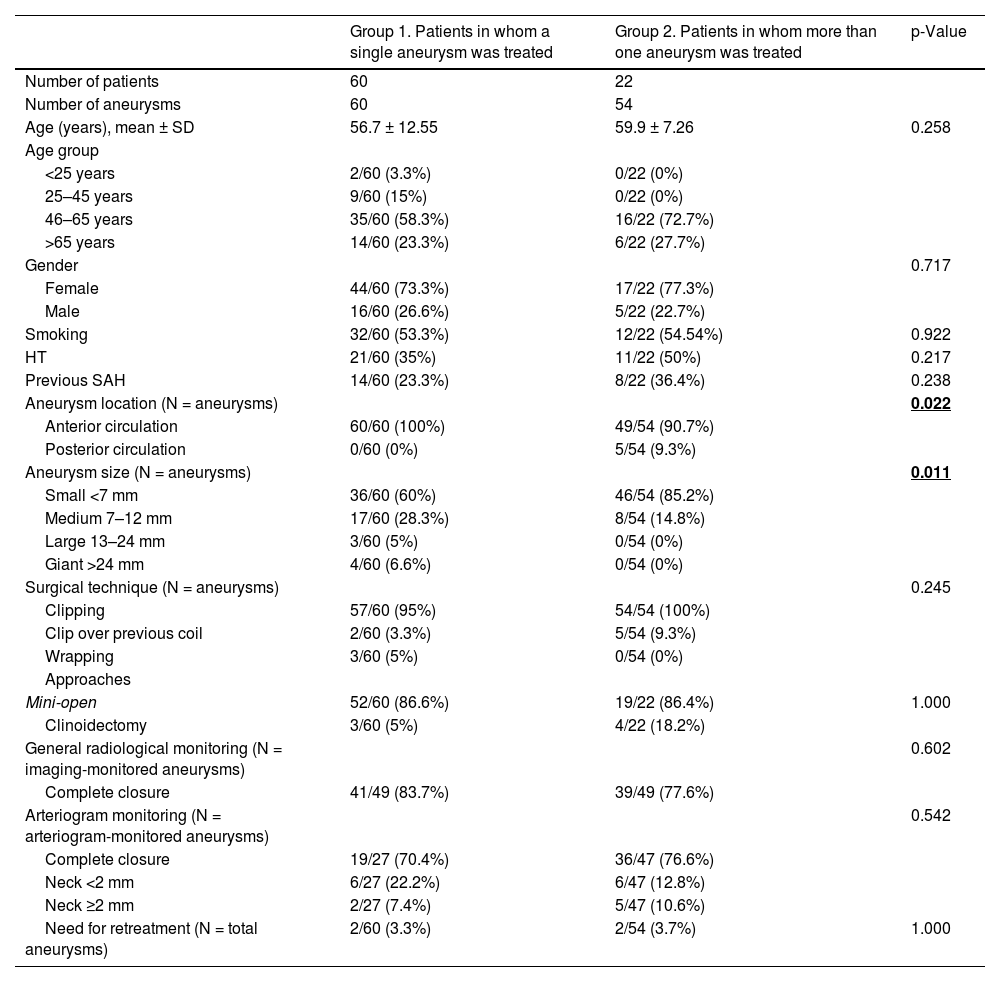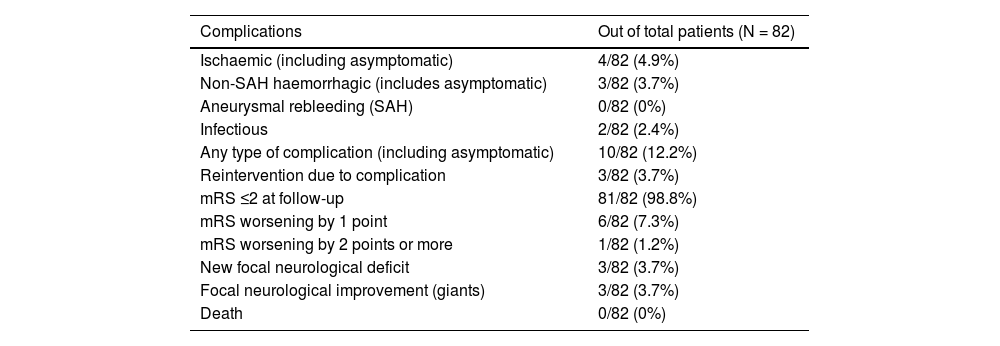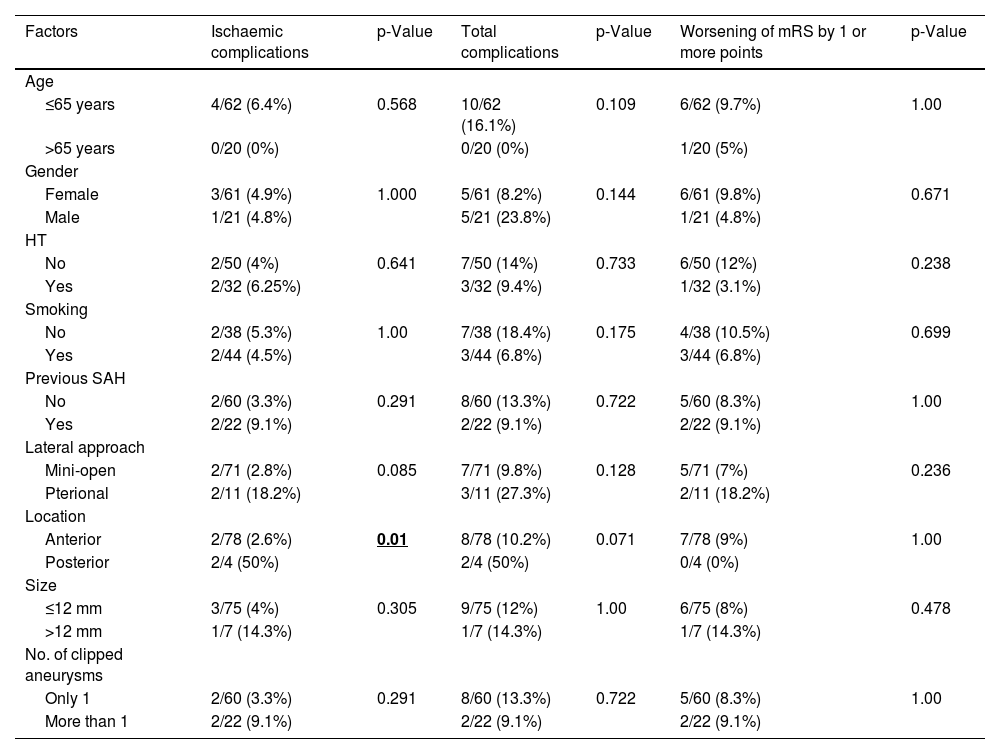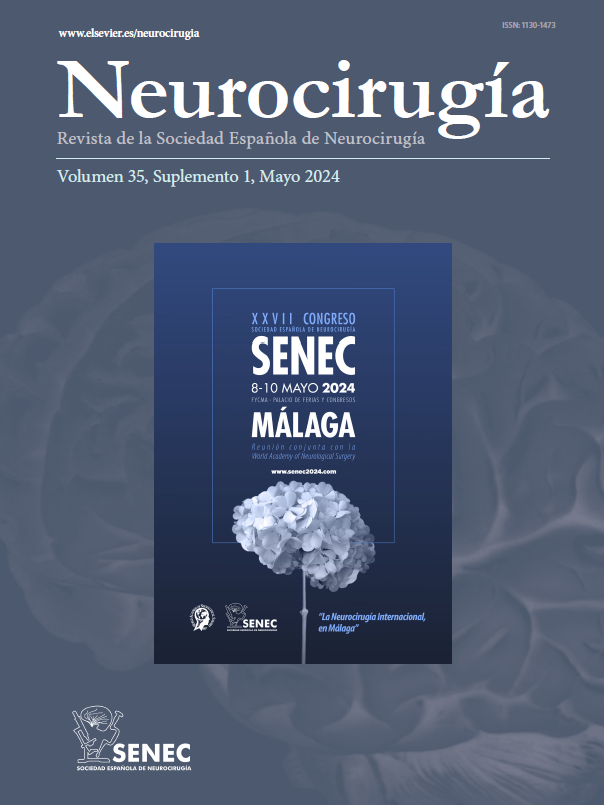The prevalence of unruptured intracranial aneurysms is 1–3%. The annual rupture rate increases in patients with multiple aneurysms that presented a previous hemorrhage from another aneurysm.
ObjectivesTo evaluate outcomes of clipping unruptured aneurysms, comparing patients with single or multiple aneurysms clipped, describe the complications related to surgery and to identify risk factors predicting an unfavorable outcome.
Materials and methodsRetrospective study including patients who underwent clipping of unruptured aneurysms between 2020–2023 at our center. Occlusion rate, complications, and functional outcome were analyzed. Risk factors for poor prognosis are identified using univariate model.
Results82 patients with 114 aneurysms were treated with microsurgery. Multiple aneurysms were clipped in 22 patients. A mini-open approach was used in 86,5% of cases. Complete occlusion in angio3D was found in 78.6% of clipped aneurysms. Complication rate was 12.2%, including asymptomatic cases. Mortality was 0%. The probability of 1 point mRS worsening was 7.3% and 2 or more points was 1.2%, with a good functional outcome in 98.9%. Clipping multiple aneurysms, miniopen approaches, or surgery in patients with previous subarachnoid hemorrhage did not increase the risk of complications. Posterior circulation aneurysms surgery increased the risk of ischemia.
ConclusionsThe management for unruptured intracranial aneurysms should be multimodal and based on clinical and radiological outcomes. Microsurgery is a valid and safe technique, with 0% mortality and bleeding rates and 1,2% rate of severe morbidity in our series.
La prevalencia de aneurismas intracraneales no rotos es de un 1-3%. La tasa de ruptura anual aumenta en pacientes con aneurismas múltiples que han sufrido una hemorragia de uno de ellos. Los objetivos son evaluar los resultados quirúrgicos del clipaje de aneurismas no rotos, comparando pacientes en los que se clipa un único o varios y describir las complicaciones de las intervenciones de aneurismas no rotos estableciendo los factores de riesgo de un pronóstico desfavorable.
Materiales y métodosEstudio retrospectivo que incluye pacientes intervenidos de aneurismas no rotos mediante microcirugía entre 2020-2023 en nuestro centro. Se analiza la tasa de cierre, las complicaciones y el resultado funcional de los pacientes. Se identifican los factores de riesgo de mal pronóstico con un modelo univariante.
ResultadosSe intervinieron 82 pacientes con 114 aneurismas. En 22 pacientes se clipó más de un aneurisma durante la intervención. El 86,5% de las intervenciones se realizaron mediante abordaje miniopen. El 78,6% de los aneurismas seguidos por arteriografía 3D presentan cierre completo. La tasa de complicaciones fue del 12,2%, incluyendo asintomáticas. La mortalidad fue del 0%. La probabilidad de empeorar el mRS 1 punto fue del 7,3% y 2 o más del 1,2%, con buen resultado funcional en el 98,9%. El clipaje de varios aneurismas en una misma intervención, empleo de minicraneotomías o la cirugía en pacientes con hemorragia subaracnoidea previa no incrementó el riesgo de complicaciones. La cirugía de aneurismas de circulación posterior aumentó el riesgo de isquemia.
ConclusionesLa indicación de cirugía de aneurismas intracraneales no rotos debe de ser consensuada multidisciplinarmente, conociendo resultados clínicos y radiológicos. La microcirugía es una técnica válida y segura, con una mortalidad 0% y una morbilidad severa del 1,2% en nuestra serie.
Article

If it is the first time you have accessed you can obtain your credentials by contacting Elsevier Spain in suscripciones@elsevier.com or by calling our Customer Service at902 88 87 40 if you are calling from Spain or at +34 932 418 800 (from 9 to 18h., GMT + 1) if you are calling outside of Spain.
If you already have your login data, please click here .
If you have forgotten your password you can you can recover it by clicking here and selecting the option ¿I have forgotten my password¿.













